To stay hydrated on the trail, prioritize drinking 1 quart of water per hour, or more in hot or high-altitude conditions. Start hydrating before your hike with 1-2 cups of water an hour before departure. Use hydration packs for ease, and sip consistently every 15-20 minutes. Monitor urine color—light yellow suggests good hydration. Include electrolyte drinks to replenish essential minerals during long hikes. Choose water over sugary drinks and plan your route with known water sources, or carry purification methods. Recognizing dehydration signs like headaches and fatigue is critical, and incorporating these strategies can enhance your trail experience.
Key Takeaways
- Drink at least 1 liter of water per hour during hikes, increasing to 1.5 liters in hot or high-altitude conditions.
- Monitor urine color to assess hydration; light yellow is ideal, while darker shades indicate dehydration.
- Use hydration gear like packs or bottles for easy and frequent water access.
- Incorporate electrolyte drinks to replenish essential minerals during prolonged exertion.
- Plan water stops using maps and local resources, and carry purification methods for natural sources.
Pre-Hike Water Needs
Guaranteeing adequate hydration before starting on a hike is essential for maintaining energy levels and endurance. Pre-hike hydration techniques should focus on preparing your body for the physical demands of the trail.
Begin by drinking 1-2 cups of water 1-2 hours prior to departure, which aids in compensating for overnight fluid loss and primes your system for efficient fluid absorption. Consistent hydration in the days leading up to the hike enhances your body's ability to retain and utilize fluids effectively, fostering long-term health benefits.
Tailor your hydration strategy to the local climate. Hotter and drier conditions necessitate increased pre-hike fluid intake to prevent dehydration and its adverse effects on performance.
Integrating electrolyte beverages alongside water can further optimize hydration by replenishing essential minerals lost through perspiration. This combination guarantees that your body remains balanced, promoting sustained energy levels throughout the hike.
Planning Water Stops
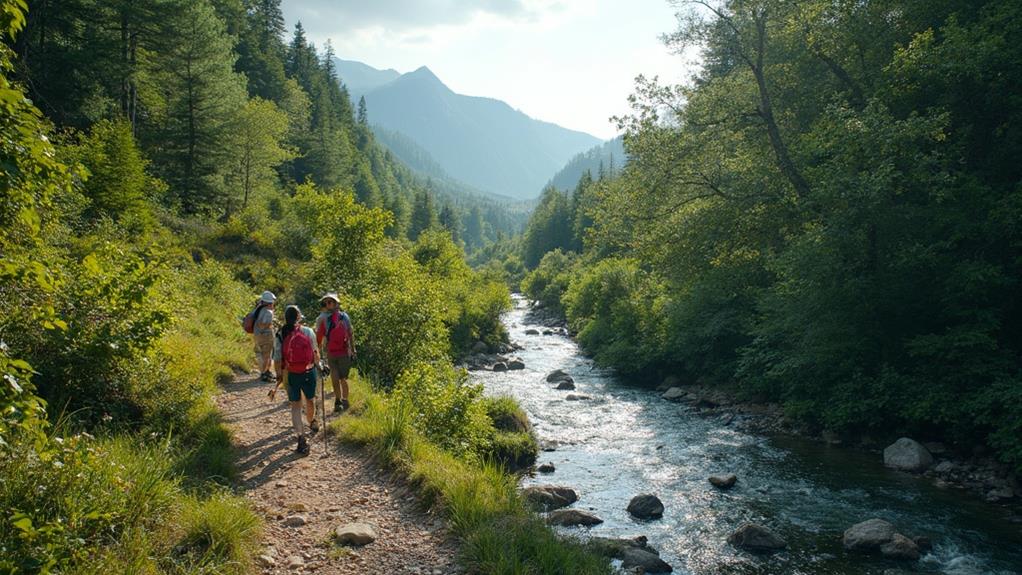
Before commencing a hike, it is essential to meticulously plan your water stops to guarantee a safe and enjoyable journey. Begin by researching and executing water source identification along your chosen route, noting their locations and distances. This preliminary step aids in effectively managing your water supply according to the hike's demands.
Contacting local agencies can provide up-to-date information on water availability, which is critical to prevent dehydration, particularly if certain trail sections are dry.
Trail mapping strategies play a significant role in planning your water stops. Utilize maps and guidebooks to evaluate the terrain and potential water sources, adjusting your itinerary based on topography and environmental factors.
Consider the hike's duration, difficulty, climate, and altitude gain to determine the volume of water you should carry, making sure you are prepared for the journey without overburdening yourself.
Additionally, pack extra water or purification methods, such as filters or tablets. These tools guarantee access to safe drinking water, especially if intended sources turn out dry or contaminated.
Starting Hydration Early
To guarantee ideal hydration during your hike, it is essential to adopt pre-hike hydration habits by consuming 1-2 cups of water, juice, or a sports drink 1-2 hours prior to setting out.
This practice not only compensates for overnight water loss but also primes your body for the physical demands ahead, enhancing endurance and energy levels.
Particularly for older adults or those with reduced thirst signals, monitoring hydration status through indicators like urine color can provide a useful check to confirm readiness for the trail.
Pre-Hike Hydration Habits
A critical component of preparing for a hike is establishing effective pre-hike hydration habits. Begin hydrating 1-2 hours before your trek by consuming 1-2 cups of water to counter overnight fluid loss and ready your body for the physical demands ahead.
It is crucial to prioritize water over sodas or energy drinks, as their sugar and caffeine content can accelerate dehydration. Pairing water intake with appropriate pre-hike snacks, like fruits or nuts, can provide a balanced source of energy and further support hydration.
Older adults should be particularly vigilant, given their tendency to have 10% less body fluid and a reduced thirst sensation. This demographic is at an increased risk for dehydration, emphasizing the importance of deliberate hydration habits. Consuming 16-24 ounces of water an hour before starting the hike guarantees you are well-prepared for the trail's challenges.
Additionally, incorporating reliable hydration gear, such as a reusable water bottle or hydration pack, facilitates immediate access to water, reinforcing good hydration practices.
Establishing a routine of drinking water upon waking sets a positive precedent for your hiking day, ensuring that peak hydration levels are maintained throughout the adventure.
Morning Water Consumption
Establishing pre-hike hydration habits naturally extends to the importance of morning water consumption, which sets the foundation for a successful day on the trail.
Beginning your day with a hydrating beverage is a crucial part of morning rituals that supports hydration motivation and guarantees readiness for the physical demands ahead. Consuming 1-2 cups (approximately 250-500 ml) of water or another hydrating drink 1-2 hours before hitting the trail counteracts the fluid loss experienced overnight.
This practice is particularly essential for older adults, who may experience diminished thirst sensations and consequently an increased risk of dehydration during physical exertion.
To enhance your preparation and performance:
- Kickstart Metabolism: Drinking water upon waking activates your metabolism, preparing your body for the exertion of hiking.
- Boost Energy Levels: Proper hydration in the morning can enhance energy levels, making it easier to maintain endurance.
- Mitigate Dehydration Risks: Prioritizing morning hydration helps reduce the risks associated with dehydration, such as fatigue and decreased performance.
- Cultivate Long-Term Habits: Establishing consistent morning hydration rituals can contribute to better hydration strategies for future hiking adventures.
Implementing these practices as part of your morning routine will guarantee you are well-prepared for any trail challenges.
Early Hydration Benefits
Before starting on a hike, prioritizing early hydration is essential for optimizing both safety and performance on the trail. Commencing hydration 1-2 hours prior to your hike is a strategic move to counteract overnight fluid loss, preparing your body for physical exertion. Drinking 1-2 cups of water before setting out guarantees you begin your hike well-hydrated, which enhances energy levels and endurance.
Contrary to common hydration myths, pre-hike hydration does not lead to unnecessary water retention but rather primes the body for effective temperature regulation, especially important in hot or humid conditions.
The benefits of early hydration extend beyond physical readiness. Mild dehydration can impair cognitive function and physical performance, so starting your hydration regimen early can greatly improve these aspects during demanding activities.
Recognizing early symptoms of dehydration, such as headaches or dizziness, can help you adjust your intake timely and avoid heat-related illnesses. Establishing a habit of early hydration not only contributes to immediate safety and performance but also fosters long-term health benefits and refined hydration strategies for future adventures.
Choosing the Right Drinks
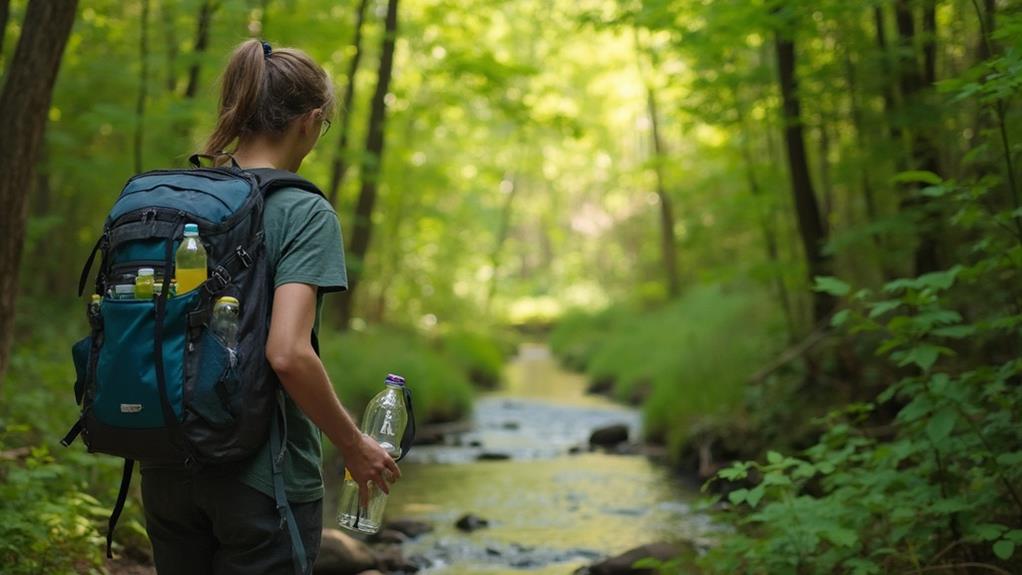
When starting on a trail adventure, selecting the right drinks is essential for ideal hydration and performance. Embracing advanced hydration technology can enhance your hiking experience by aligning with your drink preferences while ensuring safety and effectiveness.
Water remains the primary and most reliable hydration source, vital for maintaining body fluids and preventing dehydration. However, during prolonged exertion, sports drinks can play a pivotal role by providing necessary carbohydrates and electrolytes. It's critical to alternate these with water to prevent excessive sugar intake and maintain a balanced hydration status.
Incorporating the right drinks into your hiking routine involves careful considerations:
- Water: The foundation of any hydration plan, essential for fluid maintenance and overall health.
- Sports Drinks: Useful for extended hikes, providing energy and replacing lost electrolytes.
- Avoid Caffeine & Alcohol: These can lead to dehydration and impair physical performance; steer clear before and during hikes.
- Electrolyte Supplements: Tablets or drinks can be beneficial in high heat or at altitude for maintaining sodium levels.
For longer trails, complement your hydration strategy with potassium-rich snacks like bananas or citrus fruits, contributing to electrolyte balance and overall endurance.
Hydration During the Hike
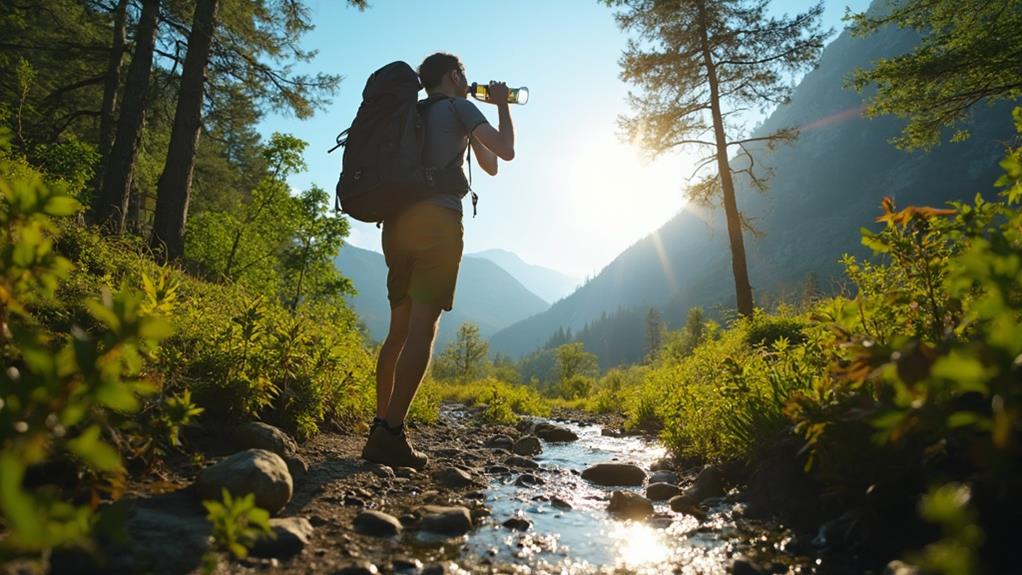
Guaranteeing adequate hydration during a hike is crucial for maintaining stamina and preventing dehydration-related issues. Employing effective hydration techniques is critical, especially in hot conditions or during strenuous activities. Aim to consume at least 1 quart (approximately 1 liter) of fluid per hour to guarantee sufficient fluid absorption and compensate for the loss through sweat. This consistent intake helps maintain ideal hydration levels, which are essential for sustained energy and performance.
Rather than relying on thirst as an indicator, proactively drinking small amounts of water at regular intervals is advisable, as thirst can often signal dehydration too late. Monitoring urine color is a reliable method to assess hydration status; aim for light yellow urine, as darker shades may indicate a need for increased fluid intake.
In extreme heat, adjusting fluid consumption upwards to at least 1 liter per hour is recommended to accommodate higher perspiration rates.
Moreover, utilizing hydration packs or soft flasks can facilitate quicker access to water, allowing hikers to maintain a steady intake without interrupting their progress. These tools support seamless hydration techniques, guaranteeing that fluids are absorbed efficiently and consistently throughout the hike, thereby enhancing safety and endurance.
Managing Water Consumption
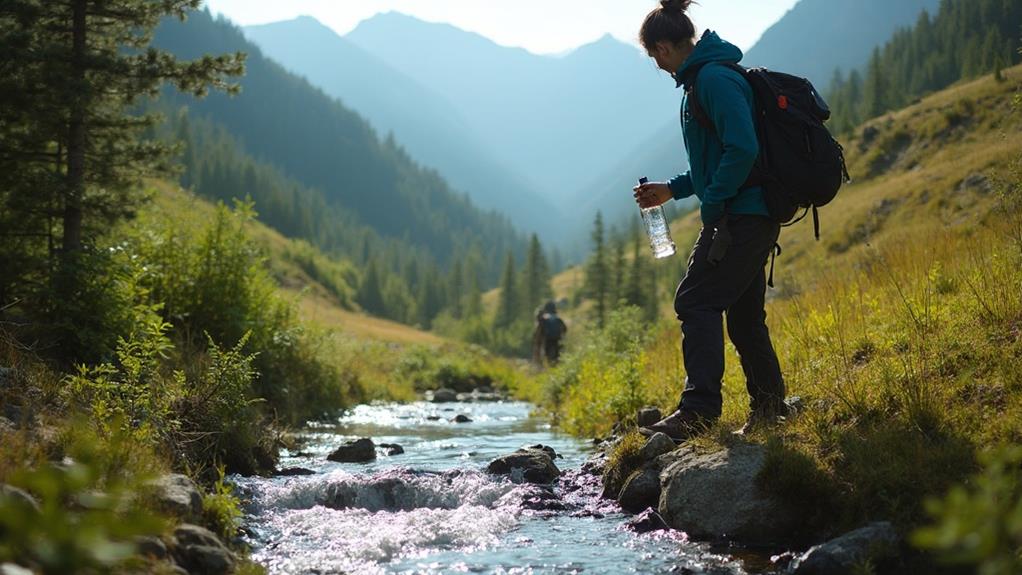
To effectively manage water consumption on the trail, hikers should aim for an ideal intake of at least 1 liter per hour, adjusting to 1.5 liters in hot or high-altitude environments to mitigate fluid loss.
Hydration timing is vital; begin by drinking 16-24 ounces of water an hour before starting your hike and continue with regular, small sips to maintain hydration without overwhelming your system.
Additionally, incorporate electrolyte drinks into your hydration plan to replenish essential minerals and prevent conditions like hyponatremia, ensuring a safe and balanced approach to staying hydrated.
Optimal Water Intake
Properly managing water consumption is vital for maintaining hydration and ensuring safety on the trail. Amidst common hydration myths, understanding ideal water intake is essential. While the general recommendation is at least 1.5 liters (1.6 quarts) daily per person, varying conditions such as high temperatures or altitudes may necessitate up to 1 liter per hour.
Prioritizing water quality is equally important—ensuring access to clean water sources can prevent illness. Implement these expert strategies to enhance hydration:
- Regular Intake: Avoid waiting for thirst; aim for 0.5 to 1 quart of fluid per hour during your hike.
- Monitor Hydration: Urine color is a key indicator; light yellow suggests proper hydration, while darker hues indicate the need for more fluids.
- Electrolyte Balance: During prolonged exertion, balance water with electrolytes to prevent overhydration conditions like hyponatremia.
- Pre-Hike Hydration: Begin hydrating 1-2 hours before the hike, consuming 16-24 ounces to prepare your body.
Hydration Timing Strategies
Effective hydration timing is essential for maintaining ideal performance and safety on the trail. Begin hydrating 1-2 hours before your hike with 16-24 ounces of water to prepare your body for the physical demands ahead. During the hike, aim to consume 0.5 to 1 quart of water per hour, adjusting for temperature and exertion levels. Set hydration reminders to drink small amounts every 15-20 minutes. Waiting until you feel thirsty, a common hydration myth, can lead to dehydration as thirst is a delayed signal.
| Timing | Action | Amount |
|---|---|---|
| 1-2 hours prior | Drink water to prepare for exertion | 16-24 ounces |
| During hike | Consume fluids regularly | 0.5-1 quart per hour |
| Every 15-20 min | Use reminders to sip water | Small amounts |
| Post-hike | Rehydrate and aid recovery | 1-2 liters |
Post-hike hydration is vital. Continue hydrating with 1-2 liters of water to replenish fluids and support recovery. Monitor your hydration status by checking urine color; a light yellow hue is indicative of adequate hydration. By understanding and implementing these strategies, hikers can effectively manage water consumption and avoid common pitfalls associated with hydration myths.
Recognizing Dehydration Signs

Dehydration is a serious concern for hikers, and recognizing its signs is essential for maintaining safety on the trail. Dehydration prevention hinges on symptom awareness, allowing hikers to address issues before they become vital. Common symptoms such as dizziness, headache, fatigue, nausea, and muscle cramps can greatly impair hiking performance and should be vigilantly monitored.
Early indicators like thirst and dry mouth may seem minor but can quickly escalate if ignored.
To effectively manage hydration, hikers should be aware of the following signs:
- Urine Color and Frequency: Dark, concentrated urine and infrequent urination are clear indicators of dehydration severity, signaling the need for immediate hydration.
- Weight Loss: Notable weight loss during hikes, even as little as 2-3% of body weight, can indicate fluid loss and necessitate prompt rehydration.
- Physical Symptoms: Headaches, muscle cramps, and fatigue are physical warnings that hydration levels need attention.
- Thirst and Dry Mouth: These early signs should be addressed promptly to prevent progression to more serious symptoms.
Maintaining awareness of personal hydration status through regular checks is essential. By understanding and responding to these signs, hikers can prevent severe dehydration, ensuring a safer and more enjoyable hiking experience.
Adjusting for Climate
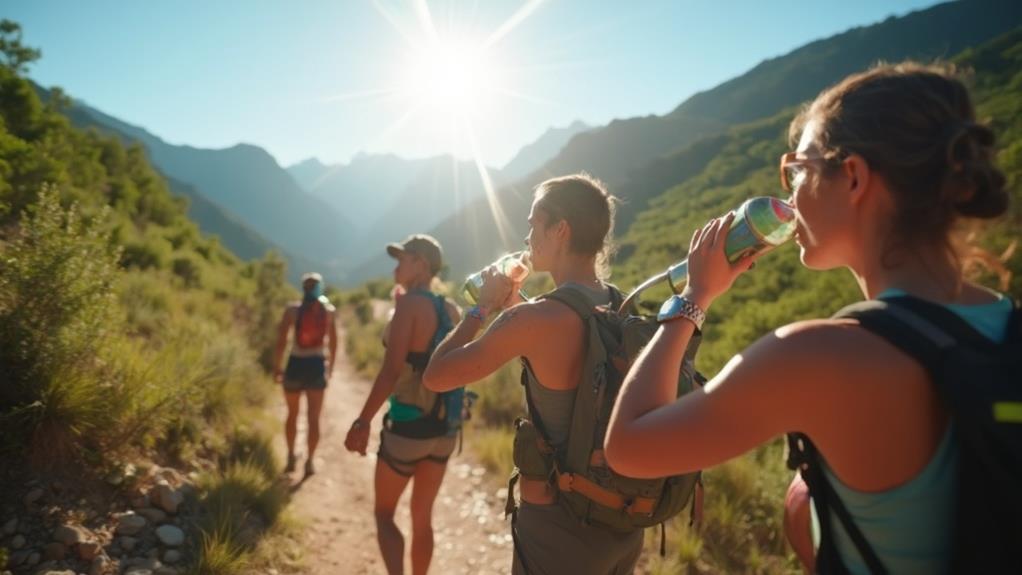
When hiking, adjusting your hydration strategy for varying climates is vital to prevent dehydration and guarantee safety on the trail.
In hot and humid conditions, the humidity effects can considerably increase sweat loss, necessitating a fluid intake of at least 1 liter per hour. This practice helps replace lost fluids and mitigates the risk of dehydration.
Conversely, at high altitudes, the lower air pressure and enhanced respiratory fluid loss demand altitude adjustments in hydration. Hikers should consume between 1 to 1.5 liters of water per hour to accommodate these conditions and maintain ideal hydration levels.
In colder weather, the sensation of thirst may diminish, yet the dry air can still lead to dehydration. It is important to aim for 0.5 to 1 liter of water per hour, ensuring continuous hydration despite the lack of thirst cues.
Additionally, the intensity of your activity plays a pivotal role in determining your hydration needs. Strenuous hikes lead to increased perspiration, necessitating additional fluid intake to match the body's demands.
Always tailor your water consumption based on personal experience and environmental conditions, as hydration requirements can vary greatly from one individual to another.
Electrolyte Balance
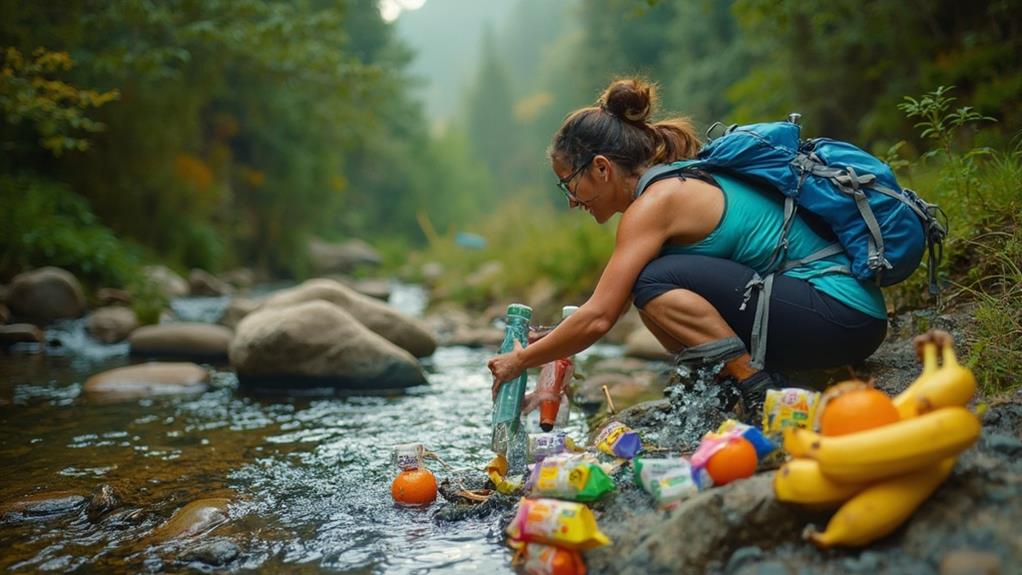
Maintaining electrolyte balance is an important aspect of safe and effective hydration while hiking. When engaging in strenuous activities, water alone is not sufficient. Excessive water intake without proper electrolytes can lead to hyponatremia, a dangerous condition characterized by low sodium levels, resulting in symptoms like nausea and confusion.
Consequently, it is crucial to include appropriate electrolyte sources in your hydration strategy.
To maintain electrolyte balance, consider the following practical tips:
- Electrolyte-rich hydration products: Use sports drinks or electrolyte tablets that provide sodium, potassium, and magnesium to support muscle function and hydration.
- Sodium intake guidelines: Aim for a sodium intake of 500-700 mg per liter of fluid consumed during prolonged physical activities to stabilize electrolyte levels.
- Potassium-rich foods: Incorporate foods like bananas and oranges into your hiking snacks, as they help regulate fluid retention and muscle function.
- Monitor hydration status: Regularly check urine color, targeting a light yellow shade, which indicates adequate hydration and electrolyte balance. Darker urine may suggest dehydration and imbalanced electrolytes.
Post-Hike Replenishment
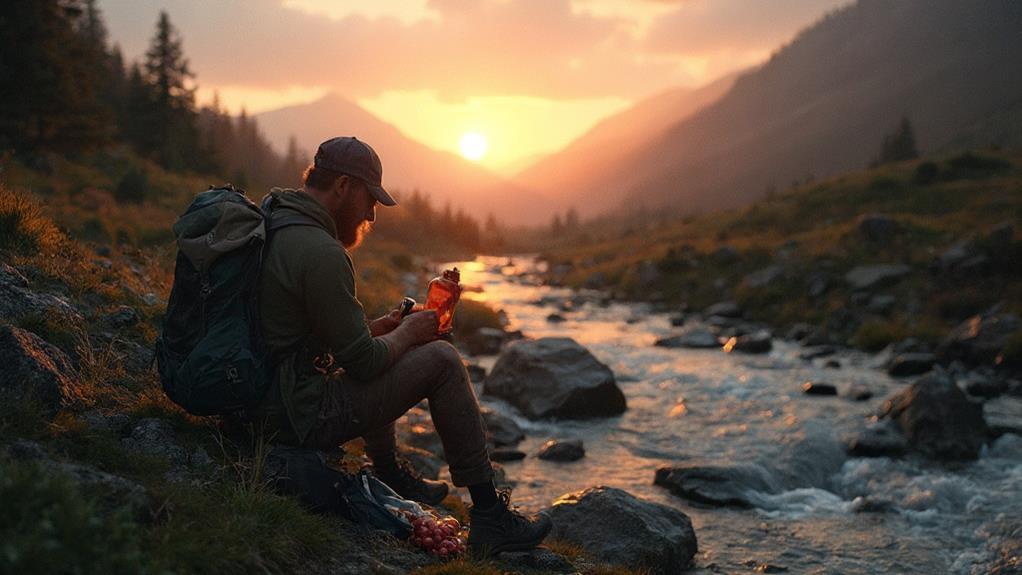
After completing a hike, it is essential to prioritize post-hike replenishment to secure full recovery and maintain overall well-being. Effective recovery strategies should include drinking an additional 1-2 liters of water to counteract fluid loss experienced during the hike. This step is vital to prevent dehydration and support the body's recovery processes.
It's a common hydration myth that once the hike ends, the need for water intake subsides; however, continuing to hydrate is important.
Incorporating electrolyte-rich beverages into your post-hike routine is recommended, especially after strenuous activities. These drinks help restore sodium levels, thereby enhancing recovery.
Monitoring physical symptoms such as thirst, fatigue, and urine color can provide insights into hydration status. Aim for light yellow urine, an indicator of sufficient hydration levels.
Weight loss during a hike often signifies fluid loss, making it important to promptly replace these fluids for peak recovery.
Consider using oral rehydration salts, which can improve fluid absorption efficiently and restore electrolyte balance.
These practical tips guarantee your body receives the necessary resources for recovery while dispelling prevalent hydration myths, ultimately promoting better health and performance on future hikes.
Hydration System Options
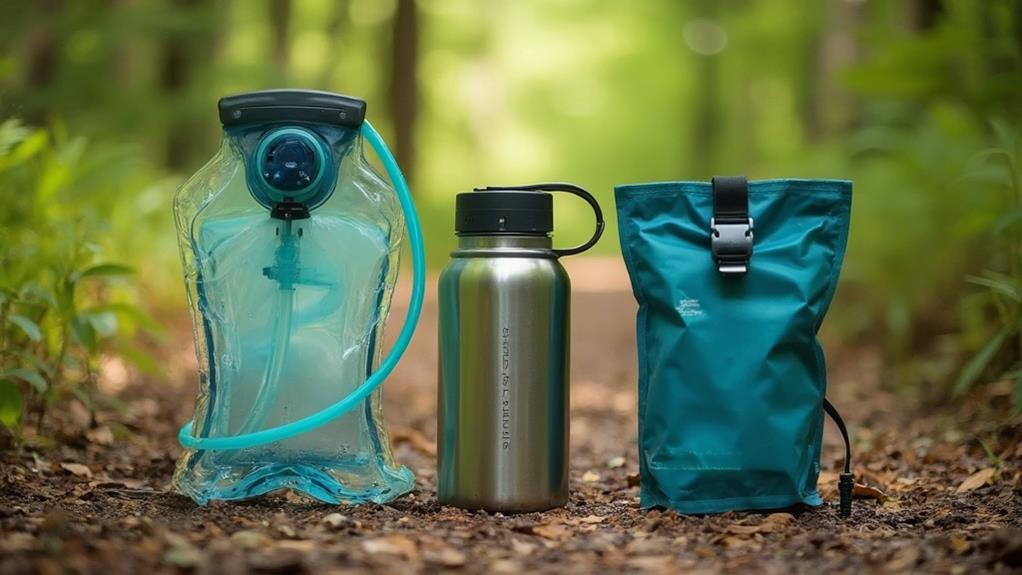
What options are available for staying hydrated on the trail? When hiking, selecting the right hydration system is vital for maintaining energy and health. Various hydration technologies cater to different needs, guaranteeing both convenience and safety.
Classic water bottles, made from diverse materials, offer straightforward accessibility, ideal for those who prefer a simple approach. For a more integrated system, hydration bladders or packs fit seamlessly inside backpacks, allowing hikers to carry less initial water while retaining access to sufficient fluid through a drinking tube.
To enhance water safety, water purification systems like filters or tablets are essential, especially when sourcing water from natural environments. These systems effectively eliminate 99.999% of bacteria, making them a reliable choice for any adventurer.
Additionally, soft reservoirs provide an adaptable option that fits inside backpacks; however, it's important to regularly check water levels due to limited visibility.
Consider these options to guarantee effective hydration on the trail:
- Classic Water Bottles: Easy access and material variety.
- Hydration Bladders: Integrated into backpacks, reducing the need for carrying excess water.
- Water Purification Systems: Essential for safe consumption from natural sources.
- Soft Flasks: Attach to shoulder straps for quick access and monitoring.
Selecting the right system enhances your hiking experience by making sure you remain hydrated and safe.
Finding Natural Water Sources
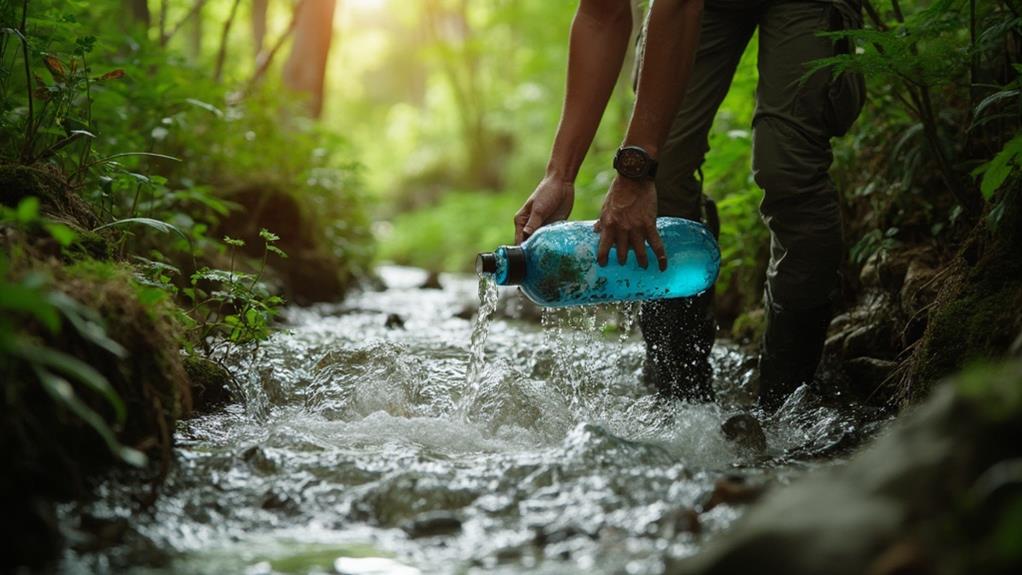
Discovering natural water sources is crucial for a successful and safe hiking experience. Stream exploration and identifying wildlife indicators can greatly enhance your ability to locate water in the wilderness. Streams, lakes, and springs are often found in shaded areas and lower elevations where moisture collects. Investigating upstream or exploring damp regions in dry creek beds can reveal hidden water closer to the surface than initially perceived.
Observing wildlife behavior is a strategic approach. Livestock and other animals often congregate around water sources, serving as natural indicators of nearby hydration spots. Utilizing these cues, along with detailed maps and local resources, helps identify known water sources along your route. Always verify the current water availability before setting out on your journey.
To guarantee the safety of water collected from these natural environments, carrying water purification methods such as filters or tablets is non-negotiable. The following table provides a quick reference guide for finding natural water sources:
| Natural Feature | Location | Indicator |
|---|---|---|
| Streams | Shaded, lower elevations | Wildlife presence |
| Lakes | Depressions, valleys | Moisture-rich vegetation |
| Springs | Rocky areas, hillsides | Damp ground, seepage |
| Dry creek beds | Damp areas, upstream sections | Cracked soil, condensation |
| Wildlife trails | Near water sources | Frequent animal tracks |
Environmental Responsibility
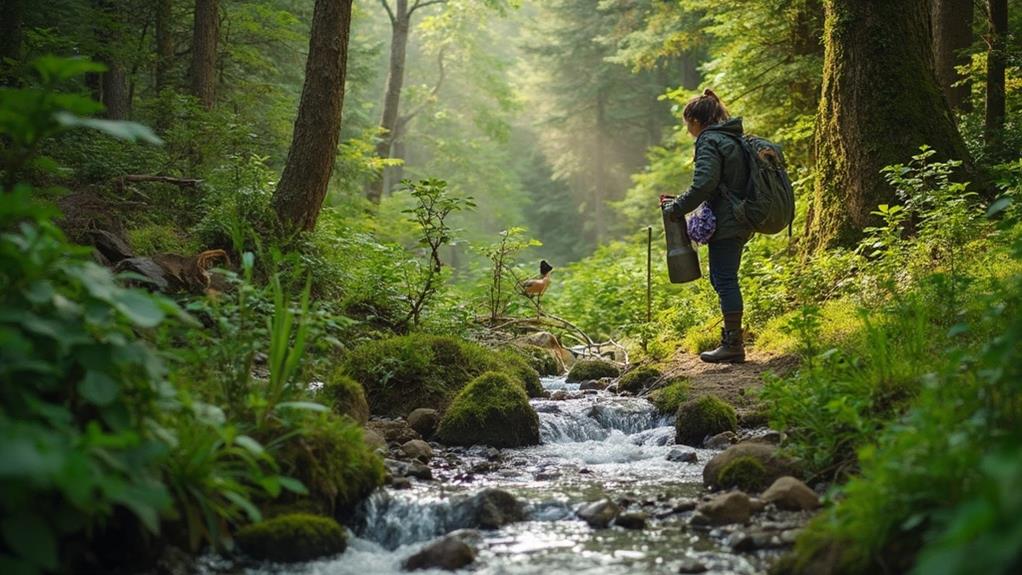
As you prioritize hydration on your hiking adventures, it is equally essential to practice environmental responsibility to guarantee the preservation of the trails and their ecosystems.
Carry a small sack for waste disposal to maintain cleanliness, and educate fellow hikers on the importance of proper waste management to safeguard wildlife and natural habitats.
Additionally, supporting local trail clean-up initiatives reinforces conservation efforts, guaranteeing these areas remain pristine and accessible for future outdoor enthusiasts.
Trail Cleanliness Practices
While enjoying the beauty of hiking trails, it is essential to prioritize environmental responsibility through proper trail cleanliness practices. Implementing effective waste management and adhering to trail etiquette are vital for preserving these natural landscapes.
Carry a small sack to collect and dispose of waste properly, ensuring that no litter is left behind. This small step greatly reduces environmental impact and helps maintain the pristine condition of the trails.
Adopt the "Leave No Trace" principles, which underscore the importance of minimizing your ecological footprint. This includes being mindful of how your actions affect the environment and ensuring natural areas remain unspoiled for future hikers.
Consider participating in local trail clean-up initiatives to support conservation efforts and demonstrate your commitment to responsible hiking.
- Waste Disposal: Always carry a small bag to pack out all trash, including biodegradable items.
- Human Waste Management: Use designated restroom areas or dig a cat hole at least 200 feet from water sources to prevent contamination.
- Trail Etiquette: Respect wildlife and other hikers by keeping noise levels down and staying on marked paths.
- Community Efforts: Join trail clean-up events to contribute to environmental preservation and awareness.
Educating Fellow Hikers
Engaging fellow hikers in environmental responsibility is a significant step in preserving the natural beauty of hiking trails. Hiker education plays an essential role in guaranteeing that these outdoor spaces remain pristine for future generations. One of the simplest yet most effective practices is carrying a small sack for waste disposal. Educating hikers on the importance of waste management helps mitigate the impact of litter on local ecosystems and wildlife, promoting a cleaner and healthier environment.
Promoting responsible hiking is another important aspect of hiker education. Encourage fellow hikers to stay on designated trails to minimize environmental damage and reduce the risk of harming plant life or disturbing wildlife habitats. By adhering to marked paths, hikers contribute to the preservation of natural areas and help maintain the trail's integrity.
Participating in trail clean-up initiatives is an excellent way to lead by example and inspire others to adopt responsible hiking practices. These events not only support conservation efforts but also raise awareness about the detrimental effects of littering.
Additionally, sharing knowledge about proper hydration strategies is essential to prevent dehydration and guarantee a safe hiking experience. Educating on these topics fosters a community of informed, environmentally-conscious hikers.
Supporting Conservation Efforts
Supporting conservation efforts on hiking trails is a pivotal component of environmental responsibility for outdoor enthusiasts. Engaging in these activities not only helps preserve natural landscapes but also guarantees their sustainability for future generations. By participating in conservation initiatives, hikers can actively contribute to the protection of ecosystems.
Here are some effective practices to take into account:
- Carry a waste disposal sack: A small sack for waste disposal prevents littering, which can harm ecosystems and wildlife, maintaining the trail's integrity.
- Join trail clean-up initiatives: Participating in these efforts aids in maintaining the natural beauty of hiking areas, fostering a collaborative approach to conservation.
- Educate fellow hikers: Sharing knowledge on responsible waste management encourages a culture of environmental stewardship, enhancing ecological education among outdoor enthusiasts.
- Support trail conservation organizations: Contributing to organizations focused on conservation and restoration guarantees the longevity and sustainability of hiking environments.
Adhering to Leave No Trace principles, such as minimizing campfire impact and respecting wildlife, is essential. This practice helps preserve natural habitats, allowing hikers to enjoy pristine environments.
Frequently Asked Questions
How to Stay Hydrated on the Trail?
To maintain hydration on the trail, implement effective hydration strategies, including pre-hike water intake, regular monitoring of hydration levels, and utilizing water filtration systems. Ascertain electrolyte balance through appropriate snacks or drinks, especially during intensive or hot hikes.
What Is the Best Hydration Drink for Hiking?
The best hydration drink for hiking combines water with electrolyte supplements to maintain ideal fluid balance. Utilizing hydration packs guarantees easy access and consistent intake, essential for safety on strenuous trails, especially during extended outdoor activities.
How Do You Get Electrolytes While Hiking?
To obtain electrolytes while hiking, consider electrolyte supplements like tablets or powders for efficient replenishment. Additionally, natural sources such as bananas, oranges, and salted nuts offer practical, safety-focused options to maintain electrolyte balance and support performance.
How Do You Stash Water on a Trail?
Efficient water storage on trails involves utilizing collapsible containers and hydration packs to strategically place water at intervals. Guarantee safety by incorporating purification methods and respecting local regulations. Hydration packs facilitate easy access, enhancing overall hiking safety and efficiency.
Conclusion
Maintaining proper hydration on the trail is essential for safety and performance. Adequate pre-hike hydration, strategic planning of water stops, and starting hydration early are vital. Selecting appropriate drinks and employing effective hydration systems enhance fluid intake. During the hike, consistent hydration must be prioritized, and post-hike replenishment should not be neglected. Utilizing natural water sources responsibly guarantees environmental sustainability. Adhering to these guidelines will help secure a safe and enjoyable hiking experience while mitigating dehydration risks.